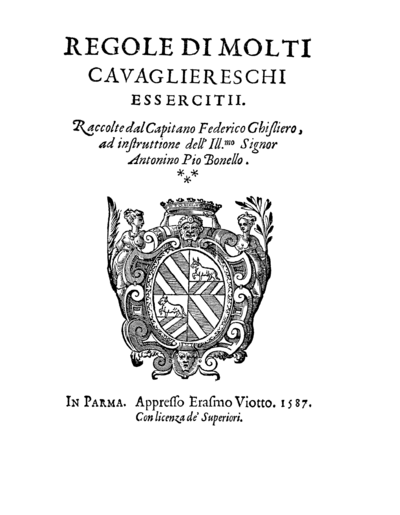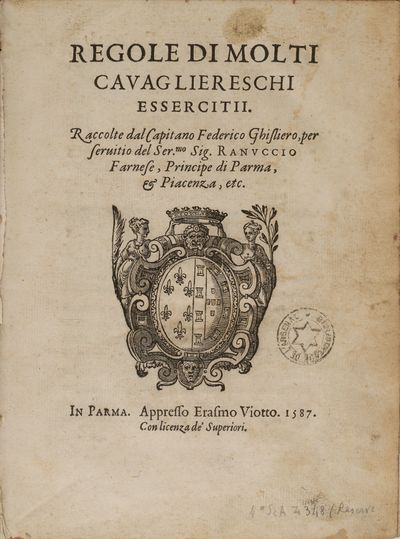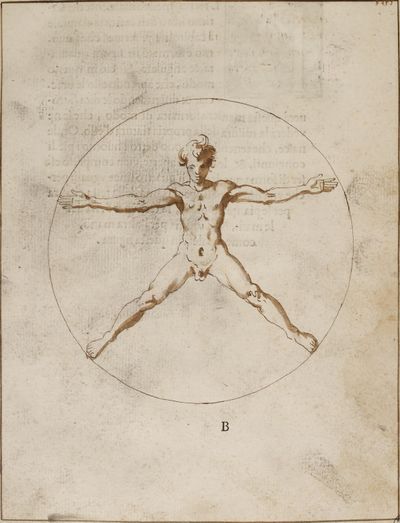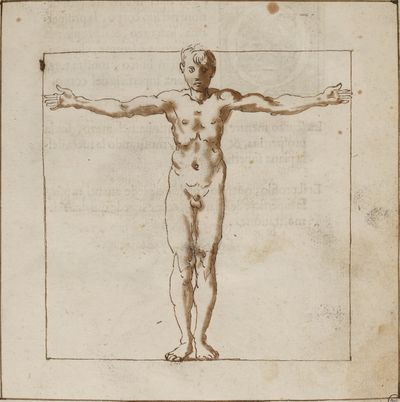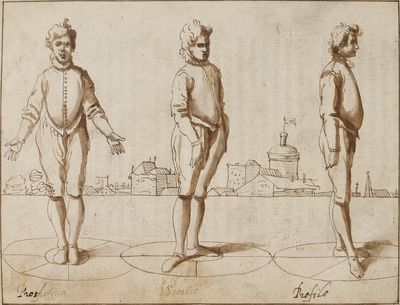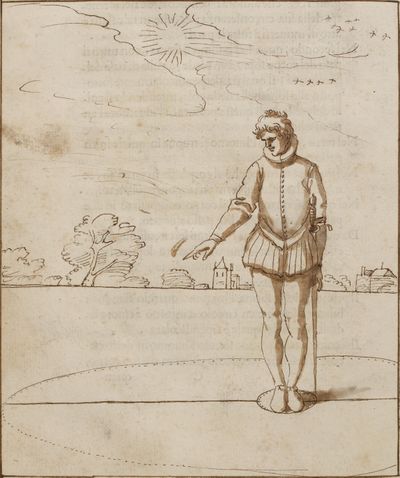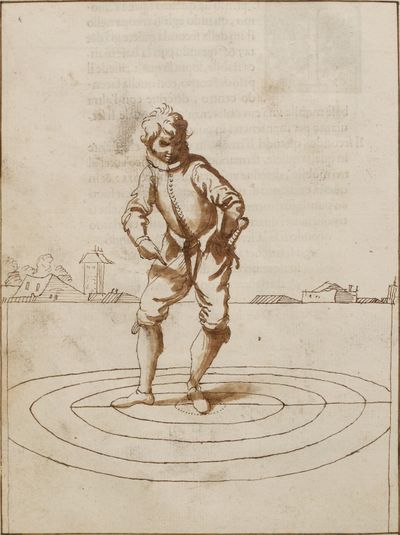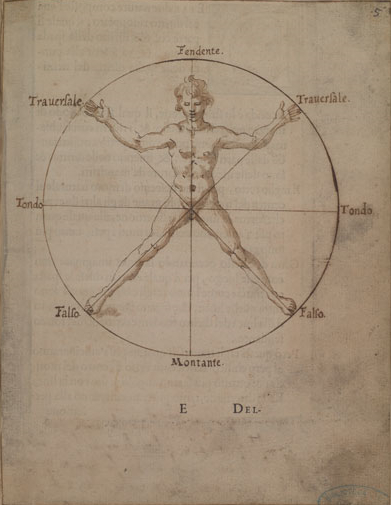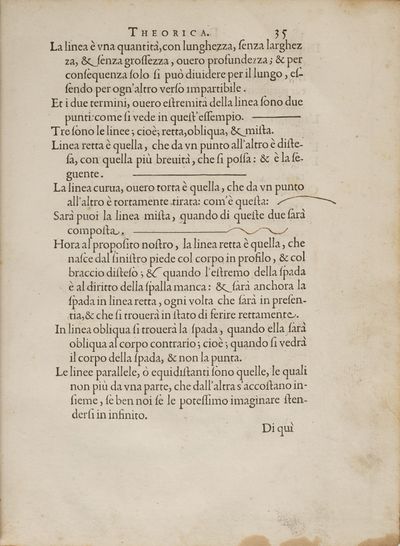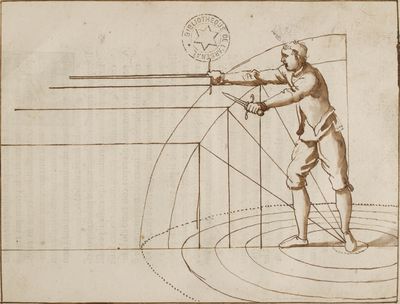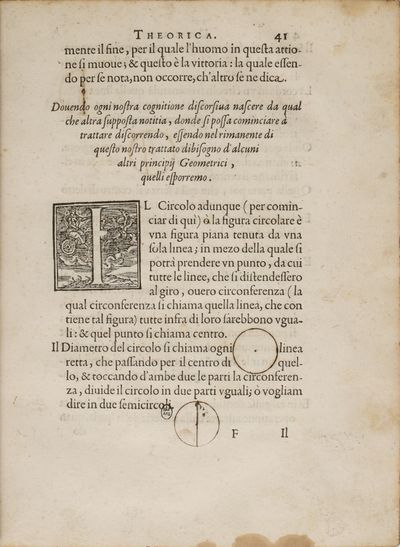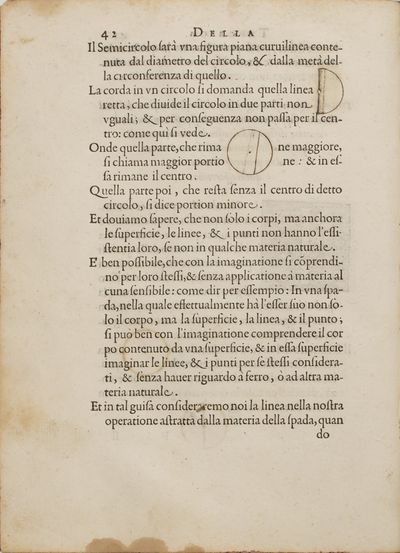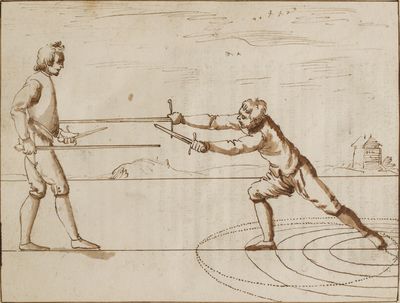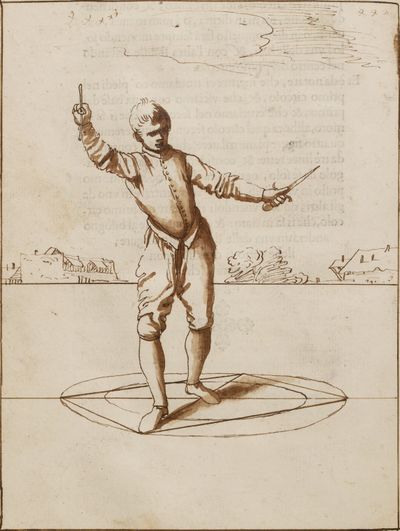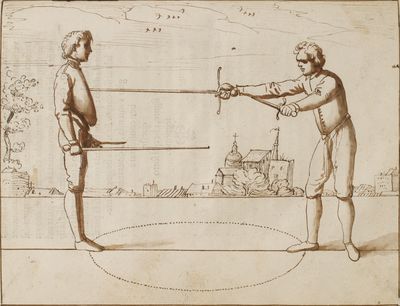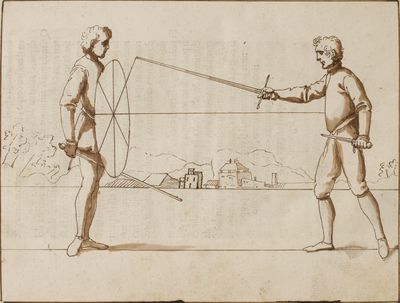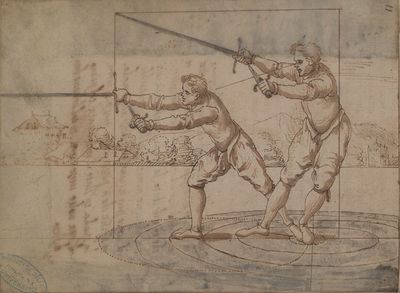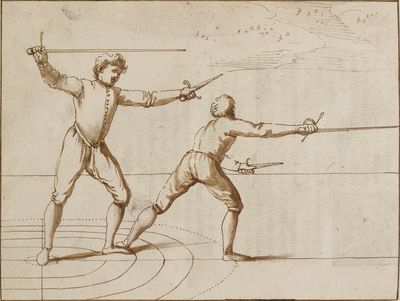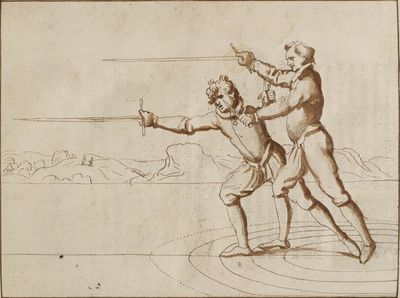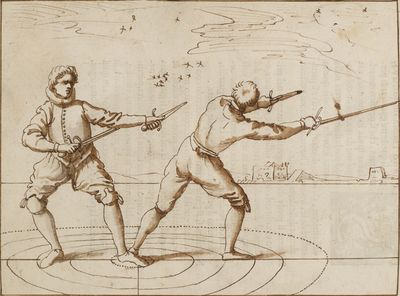|
|
You are not currently logged in. Are you accessing the unsecure (http) portal? Click here to switch to the secure portal. |
Difference between revisions of "Federico Ghisliero"
(→Temp) |
(→Temp) |
||
| (23 intermediate revisions by the same user not shown) | |||
| Line 490: | Line 490: | ||
|- | |- | ||
| rowspan="2" class="noline" | [[File:Ghisliero 05.jpg|400px|center]] | | rowspan="2" class="noline" | [[File:Ghisliero 05.jpg|400px|center]] | ||
| − | | <p> | + | | <p>'''T'''he first of the four forms of the man, when finds himself in the state of in stillness in the already mentioned position of second; and when his stance is not stable where the bodyweight resides, with one leg in the centre of the circle, it allows other leg to describe the edge of the circle, [this is the position] which we use to keep ourselves on guard.</p> |
| {{section|Page:Regole di molti cavagliereschi essercitii (Federico Ghisliero) 1587.pdf/33|1|lbl=19.1}} | | {{section|Page:Regole di molti cavagliereschi essercitii (Federico Ghisliero) 1587.pdf/33|1|lbl=19.1}} | ||
| Line 518: | Line 518: | ||
|- | |- | ||
| | | | ||
| − | | <p> | + | | <p>'''A'''s the motion, and the matter, around which the man operates in this act of stabbing them, we have to know that movement, according to what Aristotle defends in the ninth text of his fifth book of the ''Physica'',s<ref>Aristotle’s fifth book of the ''Physica'', which considers how motion occurs. “Book V classifies four species of movement, depending on where the opposites are located. Movement categories include quantity (e.g. a change in dimensions, from great to small), quality (as for colours: from pale to dark), place (local movements generally go from up downwards and vice versa), or, more controversially, substance. In fact, substances do not have opposites, so it is inappropriate to say that something properly becomes, from not-man, man: generation and corruption are not kinesis in the full sense.” (Aristotle, ''Physica'' (Book 5), (384–322 BC) 2007) “Generally things which come to be, come to be in different ways: (1) by change of shape, as a statue; (2) by addition, as things which grow; (3) by taking away, as the Hermes from the stone; (4) by putting together, as a house; (5) by alteration, as things which ‘turn’ in respect of their material substance.” Book 1, ''Physica'', Aristotle (Aristotle, ''Physica'' (Book 1), (384-322 BC) 2007)</ref> is a mutation, or transmutation: the types of which some want to be six; i.e. Generation, Corruption,<ref>Change of shape.</ref> Augmentation,<ref>By addition or by growing.</ref> Decreasing,<ref>Also taking away or removing.</ref> Alteration,<ref>Putting things together or building.</ref> and Mutation<ref>Change of material substance or alteration of its substance.</ref> place-to-place. None other than Aristotle himself in the first section<ref>“Three kinds of motion - qualitative, quantitative, and local” Book 5, ''Physica'', Aristotle (Aristotle, ''Physica'' (Book 5), (384–322 BC) 2007)</ref> concludes that there are no more than three [types of movement]; i.e. quantity, quality mutation, and location. Of these three types the last type is what we need to know for our art, in which movement is nothing more than transmutation that sometimes causes a body to move from one place to another; and the terms of the movement are two instants.</p> |
| {{section|Page:Regole di molti cavagliereschi essercitii (Federico Ghisliero) 1587.pdf/35|2|lbl=21.2}} | | {{section|Page:Regole di molti cavagliereschi essercitii (Federico Ghisliero) 1587.pdf/35|2|lbl=21.2}} | ||
| Line 605: | Line 605: | ||
|- | |- | ||
| − | | | + | | class="noline" | |
| − | | | + | | class="noline" | |
* The fifth and final one made by the man, while the whole body is stable by and centred on the hand’s wrist,<ref>“''Rascetta'', the wrist of one’s hand. Also a kind of fine silke-rash.” (Florio, 1611)</ref> describes the smallest possible circumference that he can describe; which we use to make holes in the knuckles. | * The fifth and final one made by the man, while the whole body is stable by and centred on the hand’s wrist,<ref>“''Rascetta'', the wrist of one’s hand. Also a kind of fine silke-rash.” (Florio, 1611)</ref> describes the smallest possible circumference that he can describe; which we use to make holes in the knuckles. | ||
| − | | {{section|Page:Regole di molti cavagliereschi essercitii (Federico Ghisliero) 1587.pdf/38|3|lbl=24.3}} | + | | class="noline" | {{section|Page:Regole di molti cavagliereschi essercitii (Federico Ghisliero) 1587.pdf/38|3|lbl=24.3}} |
|} | |} | ||
| Line 630: | Line 630: | ||
|- | |- | ||
| | | | ||
| − | | <p> | + | | <p>'''T'''he offensive instrument is the sword, & the dagger is the defensive one and although sometimes the sword makes the dagger’s offering by parrying; and the dagger makes the sword’s offering by attacking, this happens by accident.</p> |
| {{section|Page:Regole di molti cavagliereschi essercitii (Federico Ghisliero) 1587.pdf/38|5|lbl=24.5}} | | {{section|Page:Regole di molti cavagliereschi essercitii (Federico Ghisliero) 1587.pdf/38|5|lbl=24.5}} | ||
| Line 759: | Line 759: | ||
|- | |- | ||
| − | | | + | | class="noline" | |
| − | | <p>The defending line must be used to bring the line opposite to the center from where it originates: but when it finds itself in the center it must be beaten, and when it is not there it must be helped, so that it may arrive more quickly at its decline through natural motion.</p> | + | | class="noline" | <p>The defending line must be used to bring the line opposite to the center from where it originates: but when it finds itself in the center it must be beaten, and when it is not there it must be helped, so that it may arrive more quickly at its decline through natural motion.</p> |
| − | | {{section|Page:Regole di molti cavagliereschi essercitii (Federico Ghisliero) 1587.pdf/44|2|lbl=30.2}} | + | | class="noline" | {{section|Page:Regole di molti cavagliereschi essercitii (Federico Ghisliero) 1587.pdf/44|2|lbl=30.2}} |
|} | |} | ||
| Line 788: | Line 788: | ||
|- | |- | ||
| | | | ||
| − | | <p> | + | | <p>'''T'''he sixth condition, which is the manner in which we offend others and defend ourselves, consists principally in securing our body against the enemy’s offense; and therefore the offense will never be taken if we are not first certain of the defense. Nor will we ever defend ourselves simply, if at the same time we do not offend, for the true defense is to offend, which we will do with resolution; and if we are always the first to execute the attack.<ref>Here Ghisliero’s methods conforms to common Italian approaches of defence to: always counter an opponent’s attacks with consideration for returning the attack, always attack with concern for defence, and not attack unless secure against the opponent’s attack. [note from Henry Fox]</ref></p> |
| {{section|Page:Regole di molti cavagliereschi essercitii (Federico Ghisliero) 1587.pdf/45|1|lbl=31.1}} | | {{section|Page:Regole di molti cavagliereschi essercitii (Federico Ghisliero) 1587.pdf/45|1|lbl=31.1}} | ||
| Line 879: | Line 879: | ||
|- | |- | ||
| − | | | + | | class="noline" | |
| − | | <p>''Punta riversa'' is that which parts [wounds] as it departs.</p> | + | | class="noline" | <p>''Punta riversa'' is that which parts [wounds] as it departs.</p> |
| − | | {{section|Page:Regole di molti cavagliereschi essercitii (Federico Ghisliero) 1587.pdf/50|3|lbl=34.3}} | + | | class="noline" | {{section|Page:Regole di molti cavagliereschi essercitii (Federico Ghisliero) 1587.pdf/50|3|lbl=34.3}} |
|} | |} | ||
| Line 994: | Line 994: | ||
|- | |- | ||
| − | | | + | | class="noline" | |
| − | | <p>In order to put an end to the seven circumstances, which are involved in all human operations, it remains to know brieflythe end, for which man dies in this action; and this is victory, which being known by itself, there is no need to say any more about it.</p> | + | | class="noline" | <p>In order to put an end to the seven circumstances, which are involved in all human operations, it remains to know brieflythe end, for which man dies in this action; and this is victory, which being known by itself, there is no need to say any more about it.</p> |
| − | | | + | | class="noline" | |
{{section|Page:Regole di molti cavagliereschi essercitii (Federico Ghisliero) 1587.pdf/54|5|lbl=40.5|p=1}} {{section|Page:Regole di molti cavagliereschi essercitii (Federico Ghisliero) 1587.pdf/55|1|lbl=41.1|p=1}} | {{section|Page:Regole di molti cavagliereschi essercitii (Federico Ghisliero) 1587.pdf/54|5|lbl=40.5|p=1}} {{section|Page:Regole di molti cavagliereschi essercitii (Federico Ghisliero) 1587.pdf/55|1|lbl=41.1|p=1}} | ||
| Line 1,047: | Line 1,047: | ||
|- | |- | ||
| − | | | + | | class="noline" | |
| − | | <p>And in this way we will consider the line in our operation abstracted from the matter of the sword, when it is not present; but when it is placed in a straight line, then we will consider the line applied to the matter of the sword.</p> | + | | class="noline" | <p>And in this way we will consider the line in our operation abstracted from the matter of the sword, when it is not present; but when it is placed in a straight line, then we will consider the line applied to the matter of the sword.</p> |
| − | | | + | | class="noline" | |
{{section|Page:Regole di molti cavagliereschi essercitii (Federico Ghisliero) 1587.pdf/56|6|lbl=42.6|p=1}} {{section|Page:Regole di molti cavagliereschi essercitii (Federico Ghisliero) 1587.pdf/57|1|lbl=43.1|p=1}} | {{section|Page:Regole di molti cavagliereschi essercitii (Federico Ghisliero) 1587.pdf/56|6|lbl=42.6|p=1}} {{section|Page:Regole di molti cavagliereschi essercitii (Federico Ghisliero) 1587.pdf/57|1|lbl=43.1|p=1}} | ||
| Line 1,072: | Line 1,072: | ||
|- | |- | ||
| | | | ||
| − | | <p> | + | | <p>'''T'''he will is the one on which all our actions depend, since all the actions of the powers and of all the limbs are instruments of the will, which is the principal agent. This is in man, like a king who has a principal councillor, according to whose opinion he knows that he must do all things; and this is the intellect. He also has certain other subjects, who are like speculators; if they sometimes succeed in lying: and these are all the external, and internal senses. In addition to these, he has two other subjects, as his lieutenants; who must be ready to await the commands of the King, in order to obey him: which are the cognizable, & the irascible, which are appetitive powers: the office of which is to command the movement of the limbs. Lastly, the King has a minister, who is responsible for the execution of all that is imposed by him or by his lieutenants: and this executioner is the motivating force, who, according to his needs, uses the body and its parts as if they were instruments.</p> |
| | | | ||
{{section|Page:Regole di molti cavagliereschi essercitii (Federico Ghisliero) 1587.pdf/57|3|lbl=43.3|p=1}} {{section|Page:Regole di molti cavagliereschi essercitii (Federico Ghisliero) 1587.pdf/58|1|lbl=44.1|p=1}} | {{section|Page:Regole di molti cavagliereschi essercitii (Federico Ghisliero) 1587.pdf/57|3|lbl=43.3|p=1}} {{section|Page:Regole di molti cavagliereschi essercitii (Federico Ghisliero) 1587.pdf/58|1|lbl=44.1|p=1}} | ||
| Line 1,083: | Line 1,083: | ||
|- | |- | ||
| | | | ||
| − | | <p> | + | | <p>'''S'''cience is the knowledge of something by its causes: and the question is asked of that thing, from where comes the essence and what is its cause; and by this one can conveniently assign the reason, once it arrives.</p> |
| {{section|Page:Regole di molti cavagliereschi essercitii (Federico Ghisliero) 1587.pdf/58|3|lbl=44.3}} | | {{section|Page:Regole di molti cavagliereschi essercitii (Federico Ghisliero) 1587.pdf/58|3|lbl=44.3}} | ||
| Line 1,125: | Line 1,125: | ||
|- | |- | ||
| | | | ||
| − | | <p> | + | | <p>'''T'''he measure [distance]<ref>Measure also often called distance. The measure of something is fluid due to the fencer’s, and their opponent’s, relative proportions in each combat and other considerations regarding weaponry. “The Spanish attempt to make it more certain by using proportionality, measuring against the length of the individual.” [note by Henry Fox] [[Gérard Thibault d'Anvers]] 1628 treatise Academie de l'Espée (d'Anvers, Academie de l'Espée, 1630) “…the Distances and Instances (i.e. steps in the process of fighting) to be observed in training (which are the basic foundations and support for all the following parts) proceed from the proportions of Man, therefore without this same awareness, they cannot be duly comprehended, nor practiced with confidence. And the same goes for the Steps and Approaches, short and long, required by the variety of positions in the performance of these Exercises. From which it is apparent that one must begin with a good knowledge of the proportion of limbs and body parts, that one may at least be able to make some reasonable judgement on the reach of each movement, proportionally to the limb, or limbs, on which the movement depends, and from which it must be continued, ended, turned, returned, released, bound, or changed in a thousand different ways.” (d'Anvers, Academie de l'Espée - – Book 1 – Tableau/Plate 1 –Philosophical Discussion; Construction and Mathematics of the Circle; Concerning the Sword: Proper Length and Introduction explanation of the first plate., 1630)</ref> by which we certify the quantity of the thing, is that quantity of ground, which is between the two combatants: and up to now they have tried to gain more or less knowledge of it by practice. And many have been accustomed to measure themselves, as the Spanish do: which is uncertain.</p> |
| {{section|Page:Regole di molti cavagliereschi essercitii (Federico Ghisliero) 1587.pdf/60|3|lbl=46.3}} | | {{section|Page:Regole di molti cavagliereschi essercitii (Federico Ghisliero) 1587.pdf/60|3|lbl=46.3}} | ||
| Line 1,150: | Line 1,150: | ||
|- | |- | ||
| | | | ||
| − | | <p> | + | | <p>'''T'''ime is so closely related to, and connected with, motion, from which it can never be separated (for there can be no motion which is not slow or swift; and consequently made in more or less time) that it is necessary that it should be substantially or accidentally connected with motion; that is to say, that it should be one and the same thing; or that it should be an intrinsic accident.<ref>Distance can be measured by Time, and Time measured by Distance so in effect one is the other, and every action toward or away from an opponent is measured in both Time and Distance; he seems to say much the same thing further along. [note by Henry Fox]</ref></p> |
| {{section|Page:Regole di molti cavagliereschi essercitii (Federico Ghisliero) 1587.pdf/63|1|lbl=49.1}} | | {{section|Page:Regole di molti cavagliereschi essercitii (Federico Ghisliero) 1587.pdf/63|1|lbl=49.1}} | ||
| Line 1,254: | Line 1,254: | ||
|- | |- | ||
| | | | ||
| − | | <p> | + | | <p>'''L'''et all those who know that things must be done in their proper time and place, and never after that. We must therefore consider that, just as it is necessary to wait for it, and to choose it in order to act, so it is also necessary to take care not to let the point pass completely, at which it is good to give the thing we propose: which we call an opportunity, or conjunction; which, when lost, can rarely be regained.</p> |
| {{section|Page:Regole di molti cavagliereschi essercitii (Federico Ghisliero) 1587.pdf/67|4|lbl=53.4}} | | {{section|Page:Regole di molti cavagliereschi essercitii (Federico Ghisliero) 1587.pdf/67|4|lbl=53.4}} | ||
| Line 1,270: | Line 1,270: | ||
|- | |- | ||
| | | | ||
| − | | <p> | + | | <p>'''P'''lace is nothing other than the interior and ultimate surface of that body which contains it: which on all sides touches and approaches the ultimate, extrinsic [outward] surface of the body which is contained.</p> |
| {{section|Page:Regole di molti cavagliereschi essercitii (Federico Ghisliero) 1587.pdf/68|3|lbl=54.3}} | | {{section|Page:Regole di molti cavagliereschi essercitii (Federico Ghisliero) 1587.pdf/68|3|lbl=54.3}} | ||
| Line 1,290: | Line 1,290: | ||
|- | |- | ||
| | | | ||
| − | | <p> | + | | <p>'''S'''ince, as we have seen in the composition of man, he has his body composed of four elements, of which the two heavy ones cause the weight in him, which has the power to tend downwards; and also to resist contrary motion. That is to say, to those who would pull him backwards; and since the members of the body serve the will, as instruments of motivating virtue, we will not be able to obey them with the said elements, if the weight is not distributed in them, according to need.</p> |
| {{section|Page:Regole di molti cavagliereschi essercitii (Federico Ghisliero) 1587.pdf/69|2|lbl=55.2}} | | {{section|Page:Regole di molti cavagliereschi essercitii (Federico Ghisliero) 1587.pdf/69|2|lbl=55.2}} | ||
| Line 1,310: | Line 1,310: | ||
|- | |- | ||
| − | | rowspan="3" | [[File:Ghisliero 09.jpg|400px|center]] | + | | rowspan="3" class="noline" | [[File:Ghisliero 09.jpg|400px|center]] |
| <p>In the same way, if a man wishes to gain ground on the right or left side, he must move by carrying the weight in the middle, and then the weight on the right leg, unloading it, and then gathering the missing leg in the first circle. However, he must never be bound to use both legs to move, except when he is walking.</p> | | <p>In the same way, if a man wishes to gain ground on the right or left side, he must move by carrying the weight in the middle, and then the weight on the right leg, unloading it, and then gathering the missing leg in the first circle. However, he must never be bound to use both legs to move, except when he is walking.</p> | ||
| {{section|Page:Regole di molti cavagliereschi essercitii (Federico Ghisliero) 1587.pdf/70|4|lbl=56.4}} | | {{section|Page:Regole di molti cavagliereschi essercitii (Federico Ghisliero) 1587.pdf/70|4|lbl=56.4}} | ||
| Line 1,320: | Line 1,320: | ||
|- | |- | ||
| − | | <p>And it should be noted that while we find ourselves with our feet in the first circle, and that we leave the first circle with a leg, and that we enter the second circle, which is set in motion, then we will divide that second circle into four plane trilateral figures, closed, and contained by three straight lines. And considering each of the three circles by itself, each time that a man is placed in one of them, and wishes to enter into one of the others, he will have to return to the first circle, which is made when stationary: and then, according to need, he will go into one of the four said figures; which is demonstrated by the figure which follows.</p> | + | | class="noline" | <p>And it should be noted that while we find ourselves with our feet in the first circle, and that we leave the first circle with a leg, and that we enter the second circle, which is set in motion, then we will divide that second circle into four plane trilateral figures, closed, and contained by three straight lines. And considering each of the three circles by itself, each time that a man is placed in one of them, and wishes to enter into one of the others, he will have to return to the first circle, which is made when stationary: and then, according to need, he will go into one of the four said figures; which is demonstrated by the figure which follows.</p> |
| − | | {{section|Page:Regole di molti cavagliereschi essercitii (Federico Ghisliero) 1587.pdf/71|2|lbl=57.2}} | + | | class="noline" | {{section|Page:Regole di molti cavagliereschi essercitii (Federico Ghisliero) 1587.pdf/71|2|lbl=57.2}} |
|} | |} | ||
| Line 1,384: | Line 1,384: | ||
|- | |- | ||
| | | | ||
| − | | <p> | + | | <p>'''T'''he knowledge of arms being based on this, it has come to pass that the operations of those who have so far dealt with this matter have been various: they have either placed themselves in it, or else they have given the place, so that by parrying the enemy they might at the same time secure themselves by parrying; and by putting their sword in a straight line they might attack.</p> |
| {{section|Page:Regole di molti cavagliereschi essercitii (Federico Ghisliero) 1587.pdf/77|1|lbl=63.1}} | | {{section|Page:Regole di molti cavagliereschi essercitii (Federico Ghisliero) 1587.pdf/77|1|lbl=63.1}} | ||
| Line 1,462: | Line 1,462: | ||
|- | |- | ||
| | | | ||
| − | | <p> | + | | <p>'''B'''ut we, in order not to incur in these kinds of offences and defences, will not take care to put our sword in a straight line, nor, since there is that of the enemy, will we attempt to draw it in the said terms: on the contrary, we will act according to due reason. And because true science consists in knowing the causes of things; which, once known and removed, the effect is also removed, we shall consider the cause of such a line; which is the point of the enemy’s shoulder, and the point of our body at which the line is aimed: and each time the point of the line is removed from the extremity of our body, the effect of the line is consequently removed.</p> |
| | | | ||
{{section|Page:Regole di molti cavagliereschi essercitii (Federico Ghisliero) 1587.pdf/81|4|lbl=67.4|p=1}} {{section|Page:Regole di molti cavagliereschi essercitii (Federico Ghisliero) 1587.pdf/82|1|lbl=68.1|p=1}} | {{section|Page:Regole di molti cavagliereschi essercitii (Federico Ghisliero) 1587.pdf/81|4|lbl=67.4|p=1}} {{section|Page:Regole di molti cavagliereschi essercitii (Federico Ghisliero) 1587.pdf/82|1|lbl=68.1|p=1}} | ||
| Line 1,500: | Line 1,500: | ||
|- | |- | ||
| − | | <p> | + | | <p>'''W'''e will distinguish, therefore, that our opponent will either be in one of two states, that is, at rest, or if he departs from that state, he will be in motion.</p> |
| {{section|Page:Regole di molti cavagliereschi essercitii (Federico Ghisliero) 1587.pdf/85|1|lbl=71.1}} | | {{section|Page:Regole di molti cavagliereschi essercitii (Federico Ghisliero) 1587.pdf/85|1|lbl=71.1}} | ||
| Line 1,539: | Line 1,539: | ||
|- | |- | ||
| | | | ||
| − | | <p> | + | | <p>'''R'''eturning now to the declaration of our art, I say that when the enemy finds himself in any kind of tranquillity in his posture, we must, in order to operate with knowledge, consider the four causes which cause the effects: first of all, the efficient cause, which is man; and this is the most general and remote cause in the action of this posture; but the most propitious and particular will be the act in which man finds himself; and this act shows us the effect which can arise from it.</p> |
| {{section|Page:Regole di molti cavagliereschi essercitii (Federico Ghisliero) 1587.pdf/87|1|lbl=73.1}} | | {{section|Page:Regole di molti cavagliereschi essercitii (Federico Ghisliero) 1587.pdf/87|1|lbl=73.1}} | ||
| Line 1,583: | Line 1,583: | ||
| | | | ||
{{section|Page:Regole di molti cavagliereschi essercitii (Federico Ghisliero) 1587.pdf/88|5|lbl=74.5|p=1}} {{section|Page:Regole di molti cavagliereschi essercitii (Federico Ghisliero) 1587.pdf/89|1|lbl=75.1|p=1}} | {{section|Page:Regole di molti cavagliereschi essercitii (Federico Ghisliero) 1587.pdf/88|5|lbl=74.5|p=1}} {{section|Page:Regole di molti cavagliereschi essercitii (Federico Ghisliero) 1587.pdf/89|1|lbl=75.1|p=1}} | ||
| + | |||
| + | |- | ||
| + | | class="noline" | | ||
| + | | class="noline" | <p>In the event that our opponent should hold his sword backwards, or in a fury of presence, with his foot straight forward, as some do when they hold their swords together in order to make the ''inquartata'':<ref>''Inquartata'' means quartering step. It is a voiding action of the body which closes the inside line.</ref> or when they are in ''guardia alta in coda lunga e larga''; or with their foot short forward in a ''guardia di falcone''; or in a ''coda lunga'';<ref>“Long and high tail” guard.</ref> And even if it is finally in any kind of proportion, even if it is out of the present; we will always take care to fight with the body; and we will try to move it with our straight sides, since it is (as Aristotle says) natural to all animals.</p> | ||
| + | | class="noline" | {{section|Page:Regole di molti cavagliereschi essercitii (Federico Ghisliero) 1587.pdf/89|2|lbl=75.2}} | ||
| + | |||
| + | |} | ||
| + | {{master subsection end}} | ||
| + | |||
| + | {{master subsection begin | ||
| + | | title = Chapter 10 | ||
| + | | width = 90em | ||
| + | }} | ||
| + | {| class="master" | ||
| + | |- | ||
| + | ! <p>Images</p> | ||
| + | ! <p>{{rating|C}}<br/>by [[Nicola Boyd]]</p> | ||
| + | ! <p>Transcription<br/>by [[Nicola Boyd]]</p> | ||
| + | |||
| + | |- | ||
| + | | | ||
| + | | <p>''Now, since we have declared the proportions of the lines when they are still, we will say of those that are in motion.''</p> | ||
| + | | {{section|Page:Regole di molti cavagliereschi essercitii (Federico Ghisliero) 1587.pdf/89|3|lbl=75.3}} | ||
| + | |||
| + | |- | ||
| + | | | ||
| + | | <p>'''W'''e must therefore consider that they depart from one stillness and come to rest in another:<ref>The sequence of the combatant should always be ward – blow – ward, or stillness – motion – stillness, it is a common and practical method in quite a few treatises. [note from Henry Fox]</ref> for all attacks depart from the center of the shoulder, which is the origin of the straight line; and in the attack they also return to said center.</p> | ||
| + | | | ||
| + | {{section|Page:Regole di molti cavagliereschi essercitii (Federico Ghisliero) 1587.pdf/89|4|lbl=75.4}} | ||
| + | |||
| + | |- | ||
| + | | | ||
| + | | <p>Because all the motions of a attacked man are mixed; since, for example, in order to make a hit, it is necessary first of all to make a circular motion in order to cause a straight line, and likewise because man, in forming a attack, does so with violent and natural motion (but violent is of greater force than natural), we shall distinguish that motion has a beginning, middle and end.<ref>Examine di Grassi’s (Grassi, 1570) diagram of the thrust and movement of the arm for an example of this motion. [note from Henry Fox]</ref></p> | ||
| + | | | ||
| + | {{section|Page:Regole di molti cavagliereschi essercitii (Federico Ghisliero) 1587.pdf/89|5|lbl=75.5|p=1}} {{section|Page:Regole di molti cavagliereschi essercitii (Federico Ghisliero) 1587.pdf/90|1|lbl=76.1|p=1}} | ||
| + | |||
| + | |- | ||
| + | | | ||
| + | | <p>And in order that this treatise may be better understood, I, in this part which follows, postpone the oblique and violent movement which a man makes when he prepares his arm and brings it up and rests it in the state to make a cut or point, if it is time to attack his enemy. However, I intend to speak of the movement that is made when the arm, departing from that stillness, moves towards the attack; and this is that which is (as we have said) composed of violent and natural movement; violent with respect to the force of the moving force, which pushes and violates that weight as it descends; and natural with respect to the weight of the arm and of the sword, which by its nature tends towards the center of the earth.</p> | ||
| + | | {{section|Page:Regole di molti cavagliereschi essercitii (Federico Ghisliero) 1587.pdf/90|2|lbl=76.2}} | ||
| + | |||
| + | |- | ||
| + | | | ||
| + | | <p>Therefore, the said movement has its weak beginning, which is when it begins to descend: then it has its strong middle, which is when the arm reaches the shoulder level: in which plane is the greatest blow that man can make, because there the violence of man’s strength ends. Finally, there is the end of the force, or less strong, which is when the arm exceeds the plane of the shoulder, because the movement becomes more natural, since the violence ceases, the arm is being helped a little by the rest of the moving power.</p> | ||
| + | | | ||
| + | {{section|Page:Regole di molti cavagliereschi essercitii (Federico Ghisliero) 1587.pdf/90|3|lbl=76.3|p=1}} {{section|Page:Regole di molti cavagliereschi essercitii (Federico Ghisliero) 1587.pdf/91|1|lbl=77.1|p=1}} | ||
| + | |||
| + | |- | ||
| + | | | ||
| + | | <p>And since these three terms are distinguished differently, we must act against each of them: and because the parry is of the lowest order (as far as the sword is concerned) it should not be done: because, since nature does not allow for a vacuum, if one is the first to attack, the motion will always keep the other subject to the parry: so that in two ways we will be shielded from hostile offenses.</p> | ||
| + | | {{section|Page:Regole di molti cavagliereschi essercitii (Federico Ghisliero) 1587.pdf/91|2|lbl=77.2}} | ||
| + | |||
| + | |- | ||
| + | | | ||
| + | | <p>In the first, if we are at a distance, we will be able to injure at the beginning of the movement, so that we will entertain the opposite: which, when struck (by nature, which repels evil) will not follow once the movement has begun. And this is said to be attacked before time, while the motion is weak.</p> | ||
| + | | {{section|Page:Regole di molti cavagliereschi essercitii (Federico Ghisliero) 1587.pdf/91|3|lbl=77.3}} | ||
| + | |||
| + | |- | ||
| + | | | ||
| + | | <p>And we must be very careful that this mode of defense is done resolutely, by putting the body in profile, stretching out, and attacking the straight and hostile sides: and this for as long as the weight of the arm, or that of the moving arm, in that movement, is directed towards the center of the earth.</p> | ||
| + | | {{section|Page:Regole di molti cavagliereschi essercitii (Federico Ghisliero) 1587.pdf/91|4|lbl=77.4}} | ||
| + | |||
| + | |- | ||
| + | | | ||
| + | | <p>Moreover, swords which cut and pierce have a different effect from swords which pierce: for if we attack our opponent when his weight is already in decline with the sword, which pierces and passes, we would be well offended, but the enemy could also attack us.</p> | ||
| + | | {{section|Page:Regole di molti cavagliereschi essercitii (Federico Ghisliero) 1587.pdf/92|1|lbl=78.1}} | ||
| + | |||
| + | |- | ||
| + | | | ||
| + | | <p>And the reason is this, that if the weight of the body, which was plumb with its diameter on the flat earth’s surface, were removed from the pendulum, and from the point; that is to say, from the stillness: and that the weight were declining at its natural center, it would not be possible to withdraw that weight upwards: since all things hardly move towards the side contrary to its intrinsic inclination.</p> | ||
| + | | {{section|Page:Regole di molti cavagliereschi essercitii (Federico Ghisliero) 1587.pdf/92|2|lbl=78.2}} | ||
| + | |||
| + | |- | ||
| + | | | ||
| + | | <p>And in confirmation of this. The soul of man, which is one in itself, cannot at one and the same time be very intent on commanding the movements of his hands and other limbs, and using its senses to learn the pain of injury.</p> | ||
| + | | {{section|Page:Regole di molti cavagliereschi essercitii (Federico Ghisliero) 1587.pdf/92|3|lbl=78.3}} | ||
| + | |||
| + | |- | ||
| + | | | ||
| + | | <p>Therefore we conclude that it is excellent to attack the enemy before he has the weight of his body on the ground.</p> | ||
| + | | {{section|Page:Regole di molti cavagliereschi essercitii (Federico Ghisliero) 1587.pdf/92|4|lbl=78.4}} | ||
| + | |||
| + | |- | ||
| + | | | ||
| + | | <p>In the second way of shielding ourselves from the lines of motion, we can do this in two ways: and in the first, we can lose the ground by moving the point of our body away from it: in the first of the two ways, as we have said, when we lose a step of ground, we will come out straight with the points: and we will injure the opposite arm: or we will pass straight ahead, coming out with the point of presence: and we will also injure the weaving arm. And this is said to be attacked in time in strong motion.</p> | ||
| + | | | ||
| + | {{section|Page:Regole di molti cavagliereschi essercitii (Federico Ghisliero) 1587.pdf/92|5|lbl=78.5|p=1}} {{section|Page:Regole di molti cavagliereschi essercitii (Federico Ghisliero) 1587.pdf/93|1|lbl=79.1|p=1}} | ||
| + | |||
| + | |- | ||
| + | | class="noline" | | ||
| + | | class="noline" | <p>In the other, the attacks [wounding blows] are allowed to pass through empty spaces [voids]; and as soon as the sword passes through the rays of our vision with the strong attacks [wounding blows], which we find more effective, it attacks itself after a while in weak motion.</p> | ||
| + | | class="noline" | {{section|Page:Regole di molti cavagliereschi essercitii (Federico Ghisliero) 1587.pdf/93|2|lbl=79.2}} | ||
| + | |||
| + | |} | ||
| + | {{master subsection end}} | ||
| + | |||
| + | {{master subsection begin | ||
| + | | title = Chapter 11 | ||
| + | | width = 90em | ||
| + | }} | ||
| + | {| class="master" | ||
| + | |- | ||
| + | ! <p>Images</p> | ||
| + | ! <p>{{rating|C}}<br/>by [[Nicola Boyd]]</p> | ||
| + | ! <p>Transcription<br/>by [[Nicola Boyd]]</p> | ||
| + | |||
| + | |- | ||
| + | | | ||
| + | | <p>''But because most men do not have this subtle knowledge of how to offend others, and how to defend themselves: because men, moved by nature,<ref>Nature means their passions.</ref> parry attacks in the middle of their movement; that is, in the strong, when the arm reaches the plane of the shoulder. Therefore, in discussing the parry,<ref>Parate – parade – often later used, especially in smallsword in place of ‘parry’. [note from Henry Fox]</ref> we will choose the best one.''</p> | ||
| + | | {{section|Page:Regole di molti cavagliereschi essercitii (Federico Ghisliero) 1587.pdf/93|3|lbl=79.3}} | ||
| + | |||
| + | |- | ||
| + | | | ||
| + | | <p>'''A'''nd it is done in four ways: In the first way, all motions are helped to their declination, because all things, while they are in motion, move more easily than if they were to immediately come out of stillness. And this is done in the following way: if one were to come out of the right line with the right foot; and with the left foot, accompanied by a traverse, one helps any attack, which may come from the right side of the enemy at its declination, and then taking over with the right foot one attacks the side which is closest to us.</p> | ||
| + | | | ||
| + | {{section|Page:Regole di molti cavagliereschi essercitii (Federico Ghisliero) 1587.pdf/93|4|lbl=79.4|p=1}} {{section|Page:Regole di molti cavagliereschi essercitii (Federico Ghisliero) 1587.pdf/94|1|lbl=80.1|p=1}} | ||
| + | |||
| + | |- | ||
| + | | | ||
| + | | <p>Thus, in all attacks which come from the left side of the enemy, as in the case of blows of all three types, and of compound attacks, by exiting from the diameter of the circle towards the enemy’s left side with a transversal cut, we shall help the said lines to descend, and with the least movement we shall attack more easily.</p> | ||
| + | | {{section|Page:Regole di molti cavagliereschi essercitii (Federico Ghisliero) 1587.pdf/94|2|lbl=80.2|p=1}} | ||
|- | |- | ||
| | | | ||
| − | | <p>In the | + | | <p>In the second way of parrying we repulse the enemy’s blows: if he is disconcerted in this way (and this way is good for making the sword fall from the hand of the enemy), as soon as he makes one of the attacks (be they cutting or pointed) which come from the straight sides, we gain ground with the right foot followed by our natural hand of motion, while we seek the enemy’s left hand. And with a ''mezzo mandritto''<ref>''Mezzo mandritto'' means a half-leg cut.</ref> that line at the ''debole''; that is, in the last third towards the point of the sword; and respond with the most convenient attack. |
| − | | {{section|Page:Regole di molti cavagliereschi essercitii (Federico Ghisliero) 1587.pdf/ | + | | {{section|Page:Regole di molti cavagliereschi essercitii (Federico Ghisliero) 1587.pdf/94|3|lbl=80.3|p=1}} |
| + | |||
| + | |- | ||
| + | | class="noline" | | ||
| + | | class="noline" | <p>In the same way, all attacks that come from the left side, with the growth of the short foot, are ''mezzo riverso''<ref>''Mezzo riverso'' means a half-reversed cut.</ref> cut, which slashes towards the ground; and so, with the advance of the right foot, the enemy is wounded.</p> | ||
| + | | class="noline" | | ||
| + | {{section|Page:Regole di molti cavagliereschi essercitii (Federico Ghisliero) 1587.pdf/94|4|lbl=80.4|p=1}} {{section|Page:Regole di molti cavagliereschi essercitii (Federico Ghisliero) 1587.pdf/95|1|lbl=81.1|p=1}} | ||
| + | |||
| + | |} | ||
| + | {{master subsection end}} | ||
| + | |||
| + | {{master subsection begin | ||
| + | | title = Chapter 12 | ||
| + | | width = 90em | ||
| + | }} | ||
| + | {| class="master" | ||
| + | |- | ||
| + | ! <p>Images</p> | ||
| + | ! <p>{{rating|C}}<br/>by [[Nicola Boyd]]</p> | ||
| + | ! <p>Transcription<br/>by [[Nicola Boyd]]</p> | ||
| + | |||
| + | |- | ||
| + | | | ||
| + | | <p>''And well, we say that in addition to this method (since it is useful) there are two other ways to make the sword fall from the hand of the enemy.''</p> | ||
| + | | {{section|Page:Regole di molti cavagliereschi essercitii (Federico Ghisliero) 1587.pdf/95|2|lbl=81.2}} | ||
| + | |||
| + | |- | ||
| + | | | ||
| + | | <p>'''I'''n the first, with the sword alone, with the ''Garatusa''<ref>''Garatusa'' is Spanish for thrust. In fencing it is a technique composed of nine movements, and the participation of two and three angles, that they make to [through, from] both parts [locations, sides], from the outside and from the inside, ''arrojando'' the sword with force to the sides, and from there they return to raise it [the sword] to wound with a thrust in the face or chest. It is not safe [sure]. (Ghost Sparrow Publications, 2021)</ref> (as it is called in this way), which is done with a straight cut and with the reverse cut. With these two cuts we neet the last third of the opponent’s sword to cut to the enemy’s hand with a ''mandritto'' or ''riverso'' as our blade falls; and we must try, with a blow from our sword, to make it fall lower than the enemy’s point, and with the hook of the hand cutting the edge of the enemy’s sword. If we then try to use our blow to reach the same level, which only differs in that the point of our sword will be aimed at the enemy’s left hand, and if we use a sharp edge to cut through the false edge of the sword, we will easily achieve our goal.</p> | ||
| + | | {{section|Page:Regole di molti cavagliereschi essercitii (Federico Ghisliero) 1587.pdf/95|3|lbl=81.3}} | ||
| + | |||
| + | |- | ||
| + | | | ||
| + | | <p>In the second, we place our sword under that of the enemy, and the point of the sword rests on the right arm of the enemy: then, with our dagger placed inwards, we turn it outwards, giving the effect of a leaver: thus causing the sword to fall.</p> | ||
| + | | | ||
| + | {{section|Page:Regole di molti cavagliereschi essercitii (Federico Ghisliero) 1587.pdf/95|4|lbl=81.4|p=1}} {{section|Page:Regole di molti cavagliereschi essercitii (Federico Ghisliero) 1587.pdf/96|1|lbl=82.1|p=1}} | ||
| + | |||
| + | |- | ||
| + | | | ||
| + | | <p>In the third way of parrying, one parries all attacks with a true edge; and if one could also parry with a false one, nevertheless, since this parry is weak, we have omitted it. And placing the sword in a straight line, one parries and attacks by running the edge of the sword: and to all proportions of lines made by the right side of the enemy, one parries by guarding the entrance with the left foot, or with the right ahead: and to those, which come from the left side, one parries by turning the good edge to guard the face.</p> | ||
| + | | {{section|Page:Regole di molti cavagliereschi essercitii (Federico Ghisliero) 1587.pdf/96|2|lbl=82.2}} | ||
| + | |||
| + | |- | ||
| + | | | ||
| + | | <p>In the fourth and last, one parries all attacks by guarding the head; and this method is safer than the third, since it is not subject to deceptions; and with it one responds to that attack which is more comfortable, by receiving the blow in the first third of the sword, in the forte of the sword; then, gathering up the short foot in the parry, one prepares it for the right; one may attack either by cutting straight on or by cutting ''riverso''.</p> | ||
| + | | {{section|Page:Regole di molti cavagliereschi essercitii (Federico Ghisliero) 1587.pdf/96|3|lbl=82.3}} | ||
| + | |||
| + | |- | ||
| + | | | ||
| + | | <p>When someone is strong, he may parry covered, that is, with the sword a little crossed in the strongest part of the sword, and then wound with that attack being made more comfortable following the parry that was made.</p> | ||
| + | | {{section|Page:Regole di molti cavagliereschi essercitii (Federico Ghisliero) 1587.pdf/96|4|lbl=82.4}} | ||
| + | |||
| + | |- | ||
| + | | | ||
| + | | <p>For all these kinds of proportions of lines, which are stationary as well as in motion, since we must overcome them, it will be necessary for us to move with our bodies in four acts, which we will call guards, not because we must remain in them to await the enemy, but in order to hold him, and together to carry out the offense and defense. We shall therefore constitute four guards, since there are four attacks, and four ways of operating, which we shall show in the drawing, each having its own injury [attack].</p> | ||
| + | | | ||
| + | {{section|Page:Regole di molti cavagliereschi essercitii (Federico Ghisliero) 1587.pdf/96|5|lbl=82.5|p=1}} {{section|Page:Regole di molti cavagliereschi essercitii (Federico Ghisliero) 1587.pdf/97|1|lbl=83.1|p=1}} | ||
| + | |||
| + | |- | ||
| + | | | ||
| + | | <p>'''A'''nd the first will be this one, which is seen below; and in which, in order that the body may obey the will, we have chosen the first posture of the body invented by Polyclitus,<ref>Polykleitos's ''Doryphoros'' is an early example of this position called ''contrapposto''. See https://en.wikipedia.org/wiki/Polykleitos for examples of sculptures with this stance. (Wikipeadia, 2021)</ref> which keeps all the weight united in the left leg.</p> | ||
| + | | {{section|Page:Regole di molti cavagliereschi essercitii (Federico Ghisliero) 1587.pdf/97|2|lbl=83.2}} | ||
| + | |||
| + | |- | ||
| + | | | ||
| + | | <p>The right foot is relieved of weight, since it is the one that has to enter into motion: & the body is found in the first circle of the four, which it forms in motion: so that in a short time it can turn on all sides.</p> | ||
| + | | {{section|Page:Regole di molti cavagliereschi essercitii (Federico Ghisliero) 1587.pdf/97|3|lbl=83.3}} | ||
| + | |||
| + | |- | ||
| + | | | ||
| + | | <p>The operation with the foot straight ahead, as Vegetio says in the eighth chapter, was the custom of the ancient Romans, who, when they threw the pili,<ref>Pili (pilum or pila) was the javelin of which the Romans were armed with two along with their sword. [note by Henry Fox]</ref> kept their left foot ahead so that the blow would be of greater force, and when they used the sword they kept their right foot ahead so that the sides would be covered and the sword would be closer to the enemy.</p> | ||
| + | | | ||
| + | {{section|Page:Regole di molti cavagliereschi essercitii (Federico Ghisliero) 1587.pdf/97|4|lbl=83.4|p=1}} {{section|Page:Regole di molti cavagliereschi essercitii (Federico Ghisliero) 1587.pdf/98|1|lbl=84.1|p=1}} | ||
| + | |||
| + | |- | ||
| + | | | ||
| + | | <p>Of the three proportions of the body in this posture, the curvature is increased, or should we say the view of a face, and half a face, in order to show the enemy the least possible amount of surface. And in order not to allow the enemy only a point, it is this point, in order to remove it from the enemy’s sword, where the body bends forward with its first movement, which it does with the whole body; as we said above; and consequently the sword approaches the opposite point.</p> | ||
| + | | {{section|Page:Regole di molti cavagliereschi essercitii (Federico Ghisliero) 1587.pdf/98|2|lbl=84.2}} | ||
| + | |||
| + | |- | ||
| + | | rowspan="2" | [[File:Ghisliero 12'.jpg|400px|center|link=File:Ghisliero 12.jpg]] | ||
| + | | <p>And since the sword, while it is in its natural state, denotes the future blow, we will place it in such a proportion that it will be able to make a single attack by the posture of the hand. It should therefore be placed in such a state that, when the body is in ''scurzo'' and the arm is raised in its natural state, the sword and arm form the same line with the body. So that when a line is drawn from the extreme point of the sword, a square figure is formed as shown by the posture.</p> | ||
| + | | {{section|Page:Regole di molti cavagliereschi essercitii (Federico Ghisliero) 1587.pdf/98|3|lbl=84.3}} | ||
| + | |||
| + | |- | ||
| + | | <p>In this proportion the sword will be close to the point of contact, because turning only the fist and with it forming an equilateral triangle in motion, the sword will enter in a straight line to attack.</p> | ||
| + | | {{section|Page:Regole di molti cavagliereschi essercitii (Federico Ghisliero) 1587.pdf/98|4|lbl=84.4}} | ||
| + | |||
| + | |- | ||
| + | | | ||
| + | | <p>In his attacks, descending from the circumference to the center in natural motion from top to bottom, he will search the whole body, which is the common place of the attack: and it will be irreparable [harm] because in its motion it forms a semicircle, and because the fist forms an equilateral triangle, so the sword makes three views to the enemy’s eye.</p> | ||
| + | | | ||
| + | {{section|Page:Regole di molti cavagliereschi essercitii (Federico Ghisliero) 1587.pdf/98|5|lbl=84.5|p=1}} {{section|Page:Regole di molti cavagliereschi essercitii (Federico Ghisliero) 1587.pdf/99|1|lbl=85.1|p=1}} | ||
| + | |||
| + | |- | ||
| + | | | ||
| + | | <p>With this posture the man attacks with the fourth length, which is better than the other three; as we have said, and with a short time he parries, and attacks, and takes his [enemy’s] life.</p> | ||
| + | | {{section|Page:Regole di molti cavagliereschi essercitii (Federico Ghisliero) 1587.pdf/99|2|lbl=85.2}} | ||
| + | |||
| + | |- | ||
| + | | | ||
| + | | <p>When we have the dagger, we shall hold it in such a proportion that it can dominate the enemy’s sword, and that from here ours can dominate the enemy’s dagger; or with the left hand we shall be ready to defend.</p> | ||
| + | | {{section|Page:Regole di molti cavagliereschi essercitii (Federico Ghisliero) 1587.pdf/99|3|lbl=85.3}} | ||
| + | |||
| + | |- | ||
| + | | rowspan="2" | [[File:Ghisliero 13.jpg|400px|center]] | ||
| + | | <p>'''W'''e shall nevertheless observe that, being in this posture, we shall be able to enter into the other three; and from one into the other of these, as the need arises, only by moving with one leg and stopping with the other. As, for example, if the enemy sword were to aim at our right point, since according to the precept, once we have removed the point at which the sword is aiming, we will also remove the effect of the other foot by going out into the second circle, which is made in movement, of transversal movement, and unloading the weight of the body on the other leg, we will form the second guard.</p> | ||
| + | | {{section|Page:Regole di molti cavagliereschi essercitii (Federico Ghisliero) 1587.pdf/101|1|lbl=87.1}} | ||
| + | |||
| + | |- | ||
| + | | <p>In this second guard, since the right foot has to walk to the attack, it is relieved on the side of its weight; and the sword naturally enters into a position of ''imbroccata''; and the dagger, even though it dominates the enemy sword, is ready for defense: and with the same stroke and length of line it attacks itself, as can be seen in the following figure. </p> | ||
| + | | {{section|Page:Regole di molti cavagliereschi essercitii (Federico Ghisliero) 1587.pdf/101|2|lbl=87.2}} | ||
| + | |||
| + | |- | ||
| + | | rowspan="2" | [[File:Ghisliero 14.jpg|400px|center]] | ||
| + | | <p>'''A'''nd because, as has been said, we have divided our body into two equal parts by the diameter of the circle, that is to say, in part straight and in part left, since, as Boethius says in the Book of Divisions, any division is to be of two parts; if the enemy were to place his sword on our left-handed point, we would take that point away from the enemy’s sword with our right foot in a crosswise motion in the second circle: which we do in motion; and ''scurzo formaremo'' with our feet and our body in reverse we shall form the third guard, keeping the arm straight in a state of ''imbroccata'' and the hand well extended; which has the power to close off the enemy’s sword: as we see in this figure.</p> | ||
| + | | {{pagetb|Page:Regole di molti cavagliereschi essercitii (Federico Ghisliero) 1587.pdf|103|lbl=89}} | ||
| + | |||
| + | |- | ||
| + | | <p>'''I'''f a man is in any one of these three guards, and if, by chance, the enemy should place his sword in the present position, but at an angle, then he will enter the fourth guard by the movement of his right foot alone: if this description, which I will give below, is in itself particular, without the man finding himself in any of the said guards.</p> | ||
| + | | {{section|Page:Regole di molti cavagliereschi essercitii (Federico Ghisliero) 1587.pdf/105|1|lbl=91.1}} | ||
| + | |||
| + | |- | ||
| + | | | ||
| + | | <p>The right foot is placed next to the left foot in the first circle with the body in parallel; and by withdrawing the right foot backwards in a straight line through the diameter of the circle; which is formed on the ground, arriving in the third circumference of the third circle with the right foot; the fourth guard is formed, with the whole weight of the body in the right leg.</p> | ||
| + | | {{section|Page:Regole di molti cavagliereschi essercitii (Federico Ghisliero) 1587.pdf/105|2|lbl=91.2}} | ||
| + | |||
| + | |- | ||
| + | | class="noline" | [[File:Ghisliero 15.jpg|400px|center]] | ||
| + | | class="noline" | <p>In retreating with the right foot one makes a semi-circle with the sword; and this is placed under the crossed arm; which is kept extended, and prone to the defence; and in that strike, which is made with the right foot, one gains with the hind hand a foot of ground, to deceive the enemy; and the body is kept above the right leg to distance it from the enemy. And if one is attacked by the right, because the body is the one that first moves to the front, it does not matter that the weight is in that position. And the posture is this, which follows below.</p> | ||
| + | | class="noline" | {{section|Page:Regole di molti cavagliereschi essercitii (Federico Ghisliero) 1587.pdf/105|3|lbl=91.3}} | ||
|} | |} | ||
| Line 1,593: | Line 1,844: | ||
== Temp == | == Temp == | ||
{{master subsection begin | {{master subsection begin | ||
| − | | title = Chapter | + | | title = Chapter 13 |
| width = 90em | | width = 90em | ||
}} | }} | ||
| Line 1,601: | Line 1,852: | ||
! <p>{{rating|C}}<br/>by [[Nicola Boyd]]</p> | ! <p>{{rating|C}}<br/>by [[Nicola Boyd]]</p> | ||
! <p>Transcription<br/>by [[Nicola Boyd]]</p> | ! <p>Transcription<br/>by [[Nicola Boyd]]</p> | ||
| + | |||
| + | |- | ||
| + | | | ||
| + | | <p>''Now that we have described the theorems of this art, it remains for us to demonstrate the practice. But before describing it, since this little digression, which I am about to make, is so much in keeping with our purpose, even if it is to enter into another subject, and since it will give great pleasure to those who will make the profession, and will also serve to increase their understanding, I have decided to deal briefly, and in general, with the offences and defences of fortresses. And only only those that can be applied to our own particular faculties, in order to learn how to defend our own bodies and offend those of the enemy.''</p> | ||
| + | | {{section|Page:Regole di molti cavagliereschi essercitii (Federico Ghisliero) 1587.pdf/107|1|lbl=93.1}} | ||
| + | |||
| + | |- | ||
| + | | | ||
| + | | <p>Since the fortresses, which were naturally built on strong sites, have become weak through use, man has used his art to devise a plan for building a fortress which would be less subject to the defects which have become apparent through a new way of building.This, with the various order of ''Bellouards''; cauldrons, flattenings, finials, curtains, shoulders, parapets, ramparts, matte houses, buttresses, ditches, and ramparts; and of so many other parts, and membranes, as are seen in the books of Teti, Tartaglia Castriotto, all of whom have dealt with this.</p> | ||
| + | | | ||
| + | {{section|Page:Regole di molti cavagliereschi essercitii (Federico Ghisliero) 1587.pdf/107|2|lbl=93.2|p=1}} {{section|Page:Regole di molti cavagliereschi essercitii (Federico Ghisliero) 1587.pdf/108|1|lbl=94.1|p=1}} | ||
| + | |||
| + | |- | ||
| + | | | ||
| + | | <p>But nature, having formed the body of man in such a measured proportion, as has been said, has likewise constituted in it the fortress composed of the various orders, as we have said, with which the fortresses have been made. He has two hands, like Bellauardi, which defend the ''cortina'',<ref>''Cortina'' means a long wall running level from one bulwark to another.</ref> which is the body; and likewise he has the other parts, as will be seen in the following treatise.</p> | ||
| + | | {{section|Page:Regole di molti cavagliereschi essercitii (Federico Ghisliero) 1587.pdf/108|2|lbl=94.2}} | ||
| + | |||
| + | |- | ||
| + | | | ||
| + | | <p>And in order that the fortresses may be impregnable, it would be better if he always held back all his offences in such a way that they would offend the enemy, and in such a way that the latter would not in any way allow them to be approached; which so far it seems has not been found: for the offence is carried out in a straight line: and by that means, by which those on the inside offend the enemies; with it, those outside discover everything.</p> | ||
| + | | {{section|Page:Regole di molti cavagliereschi essercitii (Federico Ghisliero) 1587.pdf/108|3|lbl=94.3}} | ||
| + | |||
| + | |- | ||
| + | | | ||
| + | | <p>As a consequence of this, man’s fortitude must have these two conditions; that is to say:</p> | ||
| + | * one is to keep his offenses free and not subject to the enemy’s offenses | ||
| + | * the other is not to let the enemy come within his distance. | ||
| + | |||
| + | <p>We will therefore strive to keep the sword and the dagger not subject to the offence, but out of the way, as has been said, speaking of the first posture for this purpose adopted by the Illustrious Signor Silvio Piccolomini.</p> | ||
| + | | {{section|Page:Regole di molti cavagliereschi essercitii (Federico Ghisliero) 1587.pdf/108|4|lbl=94.4}} | ||
| + | |||
| + | |- | ||
| + | | | ||
| + | | <p>And just as a bulwark, when he is deprived of his offences, cannot help and defend the other, nor can he defend the ''cortina'', so each time that one of the hands, which are almost like a bulwark of the man’s ''cortina'', becomes impeded in such a way that it cannot carry out its offence, the other will remain subject to the enemy; and we will remedy this defect if we keep them free (as has been said) and ready for their task.</p> | ||
| + | | {{section|Page:Regole di molti cavagliereschi essercitii (Federico Ghisliero) 1587.pdf/109|1|lbl=95.1}} | ||
| + | |||
| + | |- | ||
| + | | | ||
| + | | <p>Not permitting the enemy to approach the ditch is considered by all good soldiers to be the best defence that can be made: because once the ditch is lost, the fortress is said to be half gained. And therefore it is the opinion of good men that every effort should be made to defend the ''strada coperta''.<ref>A ''strada coperta'' is a close walk or passage made on the top of a counter-scarpe in which the besieged may cover themselves from the enemies (Florio 1610)</ref> Which, when it is well made, can easily be defended from the archibuseria;<ref>''Archibuseria'' likely is an alternative spelling of ''archibugiera'', which are a wall with slits, in a fortress, through which a weapon can be fired.</ref> by keeping good soldiers on this wall (who at the right time and in the right place) can make strong attacks on the enemy.</p> | ||
| + | | {{section|Page:Regole di molti cavagliereschi essercitii (Federico Ghisliero) 1587.pdf/109|2|lbl=95.2}} | ||
| + | |||
| + | |- | ||
| + | | | ||
| + | | <p>From this usefulness of keeping the enemy at a distance, we must continually endeavour to ensure that our opponent never comes close to setting foot on the circumference of the second circle; which we form in such a state (as we have said above) as the edge of the ditch of our fortress, by drawing a good distance from the walls: that is to say, from the posture of ''imbroccata aventata'', without opening the compass; and with sorties, extending our legs and entering the fourth circumference; which we form in motion, compressing you in a forced step, (as we have said above) so that with greater length we may prevent the enemy.</p> | ||
| + | | | ||
| + | {{section|Page:Regole di molti cavagliereschi essercitii (Federico Ghisliero) 1587.pdf/109|3|lbl=95.3|p=1}} {{section|Page:Regole di molti cavagliereschi essercitii (Federico Ghisliero) 1587.pdf/110|1|lbl=96.1|p=1}} | ||
| + | |||
| + | |- | ||
| + | | | ||
| + | | <p>The proper time for sorties is when it rains, or if the enemy is exhaused by continuous fighting, or at mealtimes or according to the best judgment of the person who finds himself in the of needing to organise sorties.</p> | ||
| + | | {{section|Page:Regole di molti cavagliereschi essercitii (Federico Ghisliero) 1587.pdf/110|2|lbl=96.2}} | ||
| + | |||
| + | |- | ||
| + | | | ||
| + | | | ||
| + | | {{section|Page:Regole di molti cavagliereschi essercitii (Federico Ghisliero) 1587.pdf/110|3|lbl=96.3}} | ||
| + | |||
| + | |- | ||
| + | | | ||
| + | | | ||
| + | | {{section|Page:Regole di molti cavagliereschi essercitii (Federico Ghisliero) 1587.pdf/110|4|lbl=96.4}} | ||
| + | |||
| + | |- | ||
| + | | | ||
| + | | | ||
| + | | {{section|Page:Regole di molti cavagliereschi essercitii (Federico Ghisliero) 1587.pdf/110|5|lbl=96.5}} | ||
| + | |||
| + | |- | ||
| + | | | ||
| + | | | ||
| + | | | ||
| + | {{section|Page:Regole di molti cavagliereschi essercitii (Federico Ghisliero) 1587.pdf/110|6|lbl=96.6|p=1}} {{section|Page:Regole di molti cavagliereschi essercitii (Federico Ghisliero) 1587.pdf/111|1|lbl=97.1|p=1}} | ||
| + | |||
| + | |- | ||
| + | | | ||
| + | | | ||
| + | | {{section|Page:Regole di molti cavagliereschi essercitii (Federico Ghisliero) 1587.pdf/111|2|lbl=97.2}} | ||
| + | |||
| + | |- | ||
| + | | | ||
| + | | | ||
| + | | {{section|Page:Regole di molti cavagliereschi essercitii (Federico Ghisliero) 1587.pdf/111|3|lbl=97.3}} | ||
| + | |||
| + | |- | ||
| + | | class="noline" | | ||
| + | | class="noline" | | ||
| + | | class="noline" | {{section|Page:Regole di molti cavagliereschi essercitii (Federico Ghisliero) 1587.pdf/111|4|lbl=97.4}} | ||
| + | |||
| + | |} | ||
| + | {{master subsection end}} | ||
| + | |||
| + | {{master subsection begin | ||
| + | | title = Chapter 14 | ||
| + | | width = 90em | ||
| + | }} | ||
| + | {| class="master" | ||
| + | |- | ||
| + | ! <p>Images</p> | ||
| + | ! <p>{{rating|C}}<br/>by [[Nicola Boyd]]</p> | ||
| + | ! <p>Transcription<br/>by [[Nicola Boyd]]</p> | ||
| + | |||
| + | |- | ||
| + | | | ||
| + | | | ||
| + | | | ||
| + | |||
| + | |- | ||
| + | | | ||
| + | | | ||
| + | | | ||
| + | |||
| + | |- | ||
| + | | | ||
| + | | | ||
| + | | | ||
| + | |||
| + | |- | ||
| + | | | ||
| + | | | ||
| + | | | ||
| + | |||
| + | |- | ||
| + | | | ||
| + | | | ||
| + | | | ||
| + | |||
| + | |- | ||
| + | | | ||
| + | | | ||
| + | | | ||
| + | |||
| + | |- | ||
| + | | | ||
| + | | | ||
| + | | | ||
| + | |||
| + | |- | ||
| + | | | ||
| + | | | ||
| + | | | ||
| + | |||
| + | |- | ||
| + | | | ||
| + | | | ||
| + | | | ||
| + | |||
| + | |- | ||
| + | | | ||
| + | | | ||
| + | | | ||
| + | |||
| + | |- | ||
| + | | | ||
| + | | | ||
| + | | | ||
| + | |||
| + | |- | ||
| + | | | ||
| + | | | ||
| + | | | ||
| + | |||
| + | |- | ||
| + | | | ||
| + | | | ||
| + | | | ||
| + | |||
| + | |- | ||
| + | | | ||
| + | | | ||
| + | | | ||
| + | |||
| + | |- | ||
| + | | | ||
| + | | | ||
| + | | | ||
| + | |||
| + | |- | ||
| + | | | ||
| + | | | ||
| + | | | ||
| + | |||
| + | |- | ||
| + | | | ||
| + | | | ||
| + | | | ||
| + | |||
| + | |- | ||
| + | | | ||
| + | | | ||
| + | | | ||
| + | |||
| + | |- | ||
| + | | | ||
| + | | | ||
| + | | | ||
| + | |||
| + | |- | ||
| + | | | ||
| + | | | ||
| + | | | ||
| + | |||
| + | |- | ||
| + | | | ||
| + | | | ||
| + | | | ||
| + | |||
| + | |- | ||
| + | | | ||
| + | | | ||
| + | | | ||
| + | |||
| + | |- | ||
| + | | | ||
| + | | | ||
| + | | | ||
| + | |||
| + | |- | ||
| + | | | ||
| + | | | ||
| + | | | ||
| + | |||
| + | |- | ||
| + | | | ||
| + | | | ||
| + | | | ||
| + | |||
| + | |- | ||
| + | | | ||
| + | | | ||
| + | | | ||
| + | |||
| + | |- | ||
| + | | | ||
| + | | | ||
| + | | | ||
| + | |||
| + | |- | ||
| + | | | ||
| + | | | ||
| + | | | ||
| + | |||
| + | |- | ||
| + | | | ||
| + | | | ||
| + | | | ||
| + | |||
| + | |- | ||
| + | | | ||
| + | | | ||
| + | | | ||
| + | |||
| + | |- | ||
| + | | | ||
| + | | | ||
| + | | | ||
| + | |||
| + | |- | ||
| + | | | ||
| + | | | ||
| + | | | ||
| + | |||
| + | |- | ||
| + | | | ||
| + | | | ||
| + | | | ||
| + | |||
| + | |- | ||
| + | | | ||
| + | | | ||
| + | | | ||
| + | |||
| + | |- | ||
| + | | | ||
| + | | | ||
| + | | | ||
| + | |||
| + | |- | ||
| + | | | ||
| + | | | ||
| + | | | ||
| + | |||
| + | |- | ||
| + | | | ||
| + | | | ||
| + | | | ||
| + | |||
| + | |- | ||
| + | | | ||
| + | | | ||
| + | | | ||
| + | |||
| + | |- | ||
| + | | | ||
| + | | | ||
| + | | | ||
| + | |||
| + | |- | ||
| + | | | ||
| + | | | ||
| + | | | ||
| + | |||
| + | |- | ||
| + | | | ||
| + | | | ||
| + | | | ||
| + | |||
| + | |- | ||
| + | | | ||
| + | | | ||
| + | | | ||
| + | |||
| + | |- | ||
| + | | | ||
| + | | | ||
| + | | | ||
| + | |||
| + | |- | ||
| + | | | ||
| + | | | ||
| + | | | ||
| + | |||
| + | |- | ||
| + | | | ||
| + | | | ||
| + | | | ||
| + | |||
| + | |- | ||
| + | | | ||
| + | | | ||
| + | | | ||
| + | |||
| + | |- | ||
| + | | | ||
| + | | | ||
| + | | | ||
| + | |||
| + | |- | ||
| + | | | ||
| + | | | ||
| + | | | ||
| + | |||
| + | |- | ||
| + | | | ||
| + | | | ||
| + | | | ||
| + | |||
| + | |- | ||
| + | | | ||
| + | | | ||
| + | | | ||
| + | |||
| + | |- | ||
| + | | | ||
| + | | | ||
| + | | | ||
| + | |||
| + | |- | ||
| + | | | ||
| + | | | ||
| + | | | ||
| + | |||
| + | |- | ||
| + | | | ||
| + | | | ||
| + | | | ||
| + | |||
| + | |- | ||
| + | | | ||
| + | | | ||
| + | | | ||
| + | |||
| + | |- | ||
| + | | | ||
| + | | | ||
| + | | | ||
| + | |||
| + | |- | ||
| + | | | ||
| + | | | ||
| + | | | ||
|- | |- | ||
| Line 1,616: | Line 2,247: | ||
{{master end}} | {{master end}} | ||
| + | == Temp == | ||
{{master begin | {{master begin | ||
| title = Practice | | title = Practice | ||
| + | | width = 100% | ||
| + | }} | ||
| + | {{master subsection begin | ||
| + | | title = Chapter 15 | ||
| width = 90em | | width = 90em | ||
}} | }} | ||
| − | |||
{| class="master" | {| class="master" | ||
| − | |||
|- | |- | ||
! <p>Images</p> | ! <p>Images</p> | ||
! <p>{{rating|C}}<br/>by [[Nicola Boyd]]</p> | ! <p>{{rating|C}}<br/>by [[Nicola Boyd]]</p> | ||
! <p>Transcription<br/>by [[Nicola Boyd]]</p> | ! <p>Transcription<br/>by [[Nicola Boyd]]</p> | ||
| + | |||
| + | |- | ||
| + | | | ||
| + | | | ||
| + | | | ||
| + | |||
| + | |- | ||
| + | | | ||
| + | | | ||
| + | | | ||
| + | |||
| + | |- | ||
| + | | | ||
| + | | | ||
| + | | | ||
| + | |||
| + | |- | ||
| + | | | ||
| + | | | ||
| + | | | ||
| + | |||
| + | |- | ||
| + | | | ||
| + | | | ||
| + | | | ||
| + | |||
| + | |- | ||
| + | | | ||
| + | | | ||
| + | | | ||
| + | |||
| + | |- | ||
| + | | | ||
| + | | | ||
| + | | | ||
| + | |||
| + | |- | ||
| + | | | ||
| + | | | ||
| + | | | ||
| + | |||
| + | |- | ||
| + | | | ||
| + | | | ||
| + | | | ||
| + | |||
| + | |- | ||
| + | | | ||
| + | | | ||
| + | | | ||
| + | |||
| + | |- | ||
| + | | | ||
| + | | | ||
| + | | | ||
| + | |||
| + | |- | ||
| + | | | ||
| + | | | ||
| + | | | ||
| + | |||
| + | |- | ||
| + | | | ||
| + | | | ||
| + | | | ||
| + | |||
| + | |- | ||
| + | | | ||
| + | | | ||
| + | | | ||
| + | |||
| + | |- | ||
| + | | | ||
| + | | | ||
| + | | | ||
| + | |||
| + | |- | ||
| + | | | ||
| + | | | ||
| + | | | ||
| + | |||
| + | |- | ||
| + | | | ||
| + | | | ||
| + | | | ||
| + | |||
| + | |- | ||
| + | | | ||
| + | | | ||
| + | | | ||
| + | |||
| + | |- | ||
| + | | | ||
| + | | | ||
| + | | | ||
| + | |||
| + | |- | ||
| + | | | ||
| + | | | ||
| + | | | ||
| + | |||
| + | |- | ||
| + | | | ||
| + | | | ||
| + | | | ||
| + | |||
| + | |- | ||
| + | | | ||
| + | | | ||
| + | | | ||
| + | |||
| + | |- | ||
| + | | | ||
| + | | | ||
| + | | | ||
| + | |||
| + | |- | ||
| + | | | ||
| + | | | ||
| + | | | ||
| + | |||
| + | |- | ||
| + | | | ||
| + | | | ||
| + | | | ||
| + | |||
| + | |- | ||
| + | | | ||
| + | | | ||
| + | | | ||
| + | |||
| + | |- | ||
| + | | | ||
| + | | | ||
| + | | | ||
| + | |||
| + | |- | ||
| + | | | ||
| + | | | ||
| + | | | ||
| + | |||
| + | |- | ||
| + | | | ||
| + | | | ||
| + | | | ||
| + | |||
| + | |- | ||
| + | | | ||
| + | | | ||
| + | | | ||
| + | |||
| + | |- | ||
| + | | | ||
| + | | | ||
| + | | | ||
|- | |- | ||
| Line 1,639: | Line 2,428: | ||
|} | |} | ||
| + | {{master subsection end}} | ||
{{master end}} | {{master end}} | ||
Revision as of 23:37, 21 March 2024
| Federico Ghisliero | |
|---|---|
| Died | 1619 Turin, Italy |
| Occupation |
|
| Nationality | Italian |
| Genres | Fencing manual |
| Language | Italian |
| Notable work(s) | Regole di molti cavagliereschi essercitii (1587) |
Federico Ghisliero was a Bolognese soldier and fencer. Little is know about his early life, but he studied fencing under the famous Silvio Piccolomini.
In 1587, he published a fencing treatise called Regole di molti cavagliereschi essercitii, dedicated to Ranuccio Farnese, who was 18 years old at the time of publication and would become Duke of Parma, Piacenza, and Castro. Ghisliero's manual is notable for his use of geometry in relation to fencing, and the incredibly detailed illustrations, using concentric circles centered on where the fencer has placed most of their weight (often, but not always, the back foot), and illustrating multiple versions of each figure in a plate, showing the progression of the movements he describes.
Treatise
Temp
Temp
For further information, including transcription and translation notes, see the discussion page.
| Work | Author(s) | Source | License |
|---|---|---|---|
| Images | Bibliothèque nationale de France | ||
| Translation | Nicola Boyd | Rules of many knightly armies | |
| Transcription | Nicola Boyd | Index:Regole di molti cavagliereschi essercitii (Federico Ghisliero) |
Additional Resources
The following is a list of publications containing scans, transcriptions, and translations relevant to this article, as well as published peer-reviewed research.
- Anglo, Sydney (1994). "Sixteenth-century Italian drawings in Federico Ghisliero's Regole di molti cavagliereschi essercitii." Apollo 140(393): 29-36.
- Gotti, Roberto (2023). "The Dynamic Sphere: Thesis on the Third State of the Vitruvian Man." Martial Culture and Historical Martial Arts in Europe and Asia: 93-147. Ed. by Daniel Jaquet; Hing Chao and Loretta Kim. Springer.
References
- ↑ 1.0 1.1 Cavagliereschi is Corsican for "chivalrous", while the Italian is "knightly".
- ↑ La gratia is Catalan for "grace".
- ↑ Ghisliero is telling his reader that he is a soldier not a civilian swordsman, so it will have a different perspective to others, hence his later comments on siege craft. [note from Henry Fox]
- ↑ This and the previous paragraph are commending the work to the patron, justifying the work’s existence and its purpose, common in treatises of the period. [note from Henry Fox]
- ↑ It was common to refer to “ancients” in the justification of the art of swordsmanship. [note from Henry Fox]
- ↑ When ‘this art’ or ‘the art’ is referenced it means the art of fencing. [More expansively the ars militari (military arts) or for the more classical, the Arts of Mars, of which swordsmanship falls within.] [note from Henry Fox]
- ↑ Further justification by demonstration of the benefits to those who practice the art in question, also common, especially referring to defense of the person and the realm. [note from Henry Fox]
- ↑ The version dedicated to Antonino instead reads "...for the instruction of the Most Illustrious Lord Antonio Pio Bonello".
- ↑ Cavalier – cavaliere – knights – so indicating the noble nature of the art which he is presenting. [note from Henry Fox]
- ↑ The Humours.
- ↑ Means sad.
- ↑ Means calm.
- ↑ Means optimistic.
- ↑ Means bad-tempered.
- ↑ Hot-tempered.
- ↑ Moti has a number of meanings in modern Italian aside from "motion", including "motorcycle, bike, watercraft, riot, scooter".
- ↑ The use of square brackets [] shows the insertion of the translator to aid in clarity of meaning throughout the document.
- ↑ Contextually, transportar is in modern Italian trasporto and has been translated such.
- ↑ Where the word operante which means the operator or the person taking action or more simply the will is used elsewhere, I translate it to fencer as operator has the wrong connotations in English for what Ghisliaro appears to wish to convey.
- ↑ This is an application of Aristotle’s Causes, in some ways more easily explained due to the application of the sword (though this could be my fencer’s brain), especially as it develops. Ghisliero uses seven rather than four as Aristotle does, or at least using the same method of explanation. [Henry Fox]
- ↑ The spelling of secóda is seconda in modern Italian. This shortening of words through the removal of ‘n’ is common in documents of the period.
- ↑ Public roads means the location is a public road.
- ↑ Of Vitruvius’ Ten Books on Architecture. [This same book is referenced in Thibault] [note from Henry Fox]
- ↑ Or capacity.
- ↑ Flavius Vegetius Renatus' On Roman Military Matters is likely the text to which he is referring. Which was a fourth century commentary on the training of Roman legions harking back to older methods. [note from Henry Fox]
- ↑ Onde is Catalan. It is dove in Italian. Both mean ‘where’ in English.
- ↑ A second century book written by a Roman in the Attica region which encompasses the city of Athens.
- ↑ Dodrans is a Latin contraction of de-quadrans which means “a whole unit less a quarter” or three-quarters.
- ↑ Referencing the ‘ancients’ for authority was commonly used by authors of the time to demonstrate their comprehensive knowledge of the subject. It is intended to add gravitas to the treatise.
- ↑ All’hora is Catalan. Modern Italian is al tempo.
- ↑ The Elder.
- ↑ Scriue is Catalan. Modern Italian is lui scrive.
- ↑ Scurzo, does not translate appropriately from Italian. As with a number of words in Ghisliero’s treatise, it is likely a Catalase word or a unique spelling. Analysis of other treaties such as Jarod Kirby’s Italian Rapier Combat (Kirby, 2004) shows the following two definitions, on page 14 of the text, of a similar sound word that is contextually a more likely approximation of what scurzo means; “Scanso, A voidance, any evasive manoeuvre that moves the body of the direct line” and “Scanso del pie dritto, A voidance made by moving the right foot slightly off the direct line while turning the body.” So for the purposes of this translation, scurzo will mean in this text the middle stance as shown in Figure 3, i.e. a partial voiding stance halfway between perspective and profile.
- ↑ "Perspective" means front facing forward.
- ↑ Also could be interpreted as "figure".
- ↑ George Silver’s theory of the time for the hand and foot from his 1599 text Paradoxes of Defense mirrors this framework. [note from Henry Fox] (Silver, 1599)
- ↑ Et is Latin for ‘and’ in English and e in Italian.
- ↑ This is not an exact translation – it is the best approximation based on context.
- ↑ Balancia translates into ‘balance’.
- ↑ Membro translates to ‘member’, but in English a better word is limb.
- ↑ ò á mano manca la fontanella directly translates to something like ‘the hand missing the fontanelle’. This made no contextual sense, so it has been translated to ‘from the fountain of the body’ as fonta can mean ‘source’ in modern Italian. In the it states that “Fontánella, a little fountaine. Also a fontanell or cauterie [something to cauterise wounds], or rowling [turning round about, whirling or turning round], used also for the chiefe vein of a man’s body.” (Florio, 1611)
- ↑ ‘Perspective’ is forward facing as can be seen in Figure 3.
- ↑ No good translation found, contextually translating spatio to ‘space’.
- ↑ Polykleitos's Doryphoros is an early example of this position called contrapposto. See https://en.wikipedia.org/wiki/Polykleitos for examples of sculptures with this stance. (Wikipeadia, 2021)
- ↑ Polykleitos wrote a lost treatise called ‘Artistic canons of body proportions’ in 5th Century Greece which provided a reference for standard body proportions. For more information https://en.wikipedia.org/wiki/Artistic_canons_of_body_proportions (Wikipeadia, 2021)
- ↑ The act or process of passing across, over, or through.
- ↑ Aristotle’s fifth book of the Physica, which considers how motion occurs. “Book V classifies four species of movement, depending on where the opposites are located. Movement categories include quantity (e.g. a change in dimensions, from great to small), quality (as for colours: from pale to dark), place (local movements generally go from up downwards and vice versa), or, more controversially, substance. In fact, substances do not have opposites, so it is inappropriate to say that something properly becomes, from not-man, man: generation and corruption are not kinesis in the full sense.” (Aristotle, Physica (Book 5), (384–322 BC) 2007) “Generally things which come to be, come to be in different ways: (1) by change of shape, as a statue; (2) by addition, as things which grow; (3) by taking away, as the Hermes from the stone; (4) by putting together, as a house; (5) by alteration, as things which ‘turn’ in respect of their material substance.” Book 1, Physica, Aristotle (Aristotle, Physica (Book 1), (384-322 BC) 2007)
- ↑ Change of shape.
- ↑ By addition or by growing.
- ↑ Also taking away or removing.
- ↑ Putting things together or building.
- ↑ Change of material substance or alteration of its substance.
- ↑ “Three kinds of motion - qualitative, quantitative, and local” Book 5, Physica, Aristotle (Aristotle, Physica (Book 5), (384–322 BC) 2007)
- ↑ This same concept is present in Chapter 5 ‘Of tempo’ in Ridolfo Capo Ferro da Cagli’s 1610 publication Gran Simulacro dell'Arte e dell'Uso della Scherma and can be translated into the actions of the fencer undertaking the correct movements - from ward (stillness) to attack or defence (movement) to ward (stillness) again. It propounds that the fencer should always end an action in a ward. The same concept is raised in Angelo Viggiani dal Montone’s 1551 (published 1575) text Lo Schermo d'Angelo Viggiani (Montone, 1575) and Antonio Manciolino’s 1531 Opera Nova (Manciolino, 1531).
- ↑ "Violence" in this instance means outside force or against nature. The same concepts of natural and violent actions are used in Iberian swordsmanship, and they take higher guards to take advantage of this principle. [note from Henry Fox]
- ↑ Springimento is likely Springáre means ‘yarke, kicke or winze’ (Florio, 1611). Which likely means in context a preparation or a marshalling of position prior to deployment.
- ↑ Fighting at the barriers was a form of tournament bout usually performed by armoured combatants in which: a fence, a barrier, was imposed between fencers, combatants fought over the fence, and blows below the waist did not count as tournament points. [note by Henry Fox]
- ↑ Bases mean "legs". I have used "legs" wherever relevant in the translation.
- ↑ “Lacertoi, the arme from the elbow to the pitch of the shoulder. Also the brawne of sinnewes or muskles of a mans armes or legges. Also a Lizard. Also a Muskle because it is like a Lizard. Also a certain disease in a harse amongs the muskles and sinnuewes. Also a fish that grunteth as a Hog. Some have taken it also for a makrell fish.” (Florio, 1611) Thus lacertoi will be translated as the arm from the elbow to the shoulder joint.
- ↑ Keeping the elbow near the body.
- ↑ “Rascetta, the wrist of one’s hand. Also a kind of fine silke-rash.” (Florio, 1611)
- ↑ Direct translation is ‘good blade’.
- ↑ Costa “the back of a knife or weapon.” (Florio, 1611) There isn’t a common English equivalent which is a single word.
- ↑ This is consistent with Giacomo di Grassi’s treatise Ragione di adoprar sicuramente l'Arme (Grassi, 1570) which states that there is more power existing at the circumference of a circle than there is closer to the centre. [note from Henry Fox]
- ↑ Debole refers to the half of the blade from tip of the blade to one third down towards the hilt.
- ↑ Forte refers to the first third of the blade from the hilt to towards the tip.
- ↑ Placing the edge over the debole like this is the basis of the Italian gaining stringere of the sword, or the Spanish atajo. It's used to close and control the line to prevent the opponent from hitting us. [Note by Táriq ibn Jelal ibn Ziyadatallah al-Naysábúrí]
- ↑ Here Ghisliero’s methods conforms to common Italian approaches of defence to: always counter an opponent’s attacks with consideration for returning the attack, always attack with concern for defence, and not attack unless secure against the opponent’s attack. [note from Henry Fox]
- ↑ Justifications for use of the cut seem to be relatively rare in fencing treatise of the time. Ghisliero’s justifications may even be unique. [note from Henry Fox]
- ↑ The same justification for the thrust is given for the thrust being used by the legionary with the gladius, remaining more covered and it being more deadly than the cut. [note from Henry Fox]
- ↑ Fendente means vertical cut.
- ↑ Traversale – transversal or diagonal cut [sometimes squalembrato for downward or falso if rising] [note from Henry Fox]
- ↑ Tondo – horizontal cut
- ↑ Dritti – straight/forward [forehand cut, or natural cut, sometimes called mandritta] [note from Henry Fox]
- ↑ Roversi – reverse [backhand or cross-wise cut] [note from Henry Fox]
- ↑ The division for the cuts on most diagrams usually go through the navel, or heart rather than the groin in most treatise of the period. [note from Henry Fox] Gérard Thibault d'Anvers’ 1630 treatise Academie de l'Espée ‘Book 1 – Tableau/Plate 2 – Comparing the ideal figure to a real Figure; Sword Scabbards’ shows the division at the naval (d'Anvers, Academie de l'Espée, 1630) – in the text it is found in the section that begins Pour venir à la Pratique de tout ce qui a efté discouru, or “To come to the Practice of all that has been discussed” (d'Anvers, Academie de l'Espée – Book 1 – Tableau/Plate 1 – Philosophical Discussion; Construction and Mathematics of the Circle; Concerning the Sword: Proper Length and Introduction explanation of the first plate., 1630). Salvator Fabris, in his 1606 text, Sienza e Pratica d’Arme also has an illustration in the section Discorso sopra laprima guardia formata nel cauare la spada del fodero or “Discourse in the first guard formed in pulling the sword from the scabbard” demonstrates the where cuts should be made and these also shows the division at the navel rather than the groin. (Fabris, 1606)
- ↑ Diritto ridoppiato literally means right redoubled or a falso traversale meaning a diagonal rising cut.
- ↑ Stramazzóne means a circular cut where the hand is the centre of rotation for the cut. [Note by Táriq ibn Jelal ibn Ziyadatallah al-Naysábúrí] Florio describes it as ‘Stramazzóne, a downe-right blow. Also a rap, a cuffe or wherret on the cheeke.” (Florio, 1611)
- ↑ ‘Molinello, or Molinelli means a circular cut. [Note by Táriq ibn Jelal ibn Ziyadatallah al-Naysábúrí] As an aside, the Molinello for flags described in Francesco Fernando Alfieri’s 1638 treatise La Bandiera “The molinello is delightful. To perform it comfortably, you should have the standard in your right hand. You complete a full turn above the head, then throw it up in the air, catching it around the middle of the standard as the figure shows. The molinello is then turned towards the rear foot. After several rotations, as the hand becomes fatigued, you should grip the butt of the flag with your other hand and repeat the same lesson, again throwing it in the air as described above.” (Alferi, 1638)
- ↑ ‘World’ is translated from the word Mondo which means “the world, the universe. Also, a Mound or Globe, as Princes hold in their hands. Also, cleane, cleansed, pure, neate, spotlesse, purged. Also, pared, pilled. Also, winnowed, &c. Also, as we say, a world, a multitude or great quantitie.’ (Florio, 1611)
- ↑ Fendente tondo means the upper half of the circle as shown in figure 6B. When speaking of the reverses, he is speaking of the lower half of the circle in figure 6B.
- ↑ ‘Segáre, to sawe. Also to part, to cut or devide through the middle.’ (Florio, 1611)
- ↑ ‘Riversa’ [singular] t de’roversi, which means ‘to turn around, a reversion, reverting, reverse or a backblow. A powering down or overwhelmed’ – in short the riversa is a back-hand. (Florio, 1611) Note how even the cut from the wrist is aided by motion of the body, no doubt using the feet to move the body as the cut is made as well, all in their correct motion, to affect the cut. [Note from Henry Fox]
- ↑ Imbroccata means a descending thrust. Stoccata, means a violent thrust ascending or rising. Punta riversa means a reverse thrust with the point of the sword.
- ↑ “Auentáta, a hurling, looke Auentáre.” (Florio, 1611) “Auentáre, to hurle, to fling, to dart or cast with violence. Also, to leape or seaze greedily upon, to souse downe as a hawke, also to fill or puff with winde.” (Florio 1611 Dictionary). Therefore imbroccata aventata or imbroccata aventate means to violently attack using a thrust of the rapier over the dagger.
- ↑ The first two lines on the page are printed, but the second two needed to be drawn in by the artist.
- ↑ Here the page numbers jump from 35 to 38, correcting the error of having two 32s and 33s
- ↑ This is the reason that the direct thrust from the shoulder in a straight line is the longest and most preferable and the reason to learn to thrust straight rather than aiming up toward the head. [Note by Henry Fox]
- ↑ 89.0 89.1 89.2 89.3 89.4 89.5 There is a gap in the text here for a circle to be drawn in.
- ↑ The effect of these causes is the fencer hitting their opponent using the technique. Poor technique means the fencer misses and/or dies.
- ↑ The material causes are the movements of the fencer’s body and sword.
- ↑ The formal cause is how the fencer uses the movements of the material cause.
- ↑ The factual cause is the fencer, with their measurements and proportions, and their ability to perform the material causes.
- ↑ The final cause is the actual technique the fencer is trying to achieve.
- ↑ Measure also often called distance. The measure of something is fluid due to the fencer’s, and their opponent’s, relative proportions in each combat and other considerations regarding weaponry. “The Spanish attempt to make it more certain by using proportionality, measuring against the length of the individual.” [note by Henry Fox] Gérard Thibault d'Anvers 1628 treatise Academie de l'Espée (d'Anvers, Academie de l'Espée, 1630) “…the Distances and Instances (i.e. steps in the process of fighting) to be observed in training (which are the basic foundations and support for all the following parts) proceed from the proportions of Man, therefore without this same awareness, they cannot be duly comprehended, nor practiced with confidence. And the same goes for the Steps and Approaches, short and long, required by the variety of positions in the performance of these Exercises. From which it is apparent that one must begin with a good knowledge of the proportion of limbs and body parts, that one may at least be able to make some reasonable judgement on the reach of each movement, proportionally to the limb, or limbs, on which the movement depends, and from which it must be continued, ended, turned, returned, released, bound, or changed in a thousand different ways.” (d'Anvers, Academie de l'Espée - – Book 1 – Tableau/Plate 1 –Philosophical Discussion; Construction and Mathematics of the Circle; Concerning the Sword: Proper Length and Introduction explanation of the first plate., 1630)
- ↑ Approximately 46 to 50 inches or 117cm to 127cm.
- ↑ Approximately 69 to 75 inches or 175cm to 191cm.
- ↑ Distance can be measured by Time, and Time measured by Distance so in effect one is the other, and every action toward or away from an opponent is measured in both Time and Distance; he seems to say much the same thing further along. [note by Henry Fox]
- ↑ Aristotelian motion is the consideration of “a stillness and motion” and is used by Capo Ferro as a method of reading the opponent in Chapter 5 ‘Of Tempo’ (Cagli’, 1610) [note by Henry Fox]
- ↑ Obligatory motion is the beginning of second intention. The fencer moves in a particular way so that the opponent has to do something in response, and then the fencer can follow on with their plan. [Note by Henry Fox]
- ↑ I will start using tempo from this point on instead of time when describing time as a measure of distance, to differentiate between it and the common use of the word time. Following Ghisliero’s explanation of tempo, it will be easier to use tempo to encapsulate this meaning.
- ↑ Sometimes extended to botta lunga, depending on the author [note by Henry Fox].
- ↑ “Attack into preparation” is what it is called in modern nomenclature, catching the opponent while they are preparing to act. [note by Henry Fox]
- ↑ An action in half-time, because the action is in motion, thus not completed, interrupted. [note by Henry Fox]
- ↑ This is an important note; the sword is extended and the fencer is covered by the extension of the sword in a straight line. [note from Henry Fox]
- ↑ Strongest third of the blade from the hilt toward the middle.
- ↑ Strongest third of the blade from the hilt toward the middle.
- ↑ Note the positions of the weapons relative to one another. This is consistent with the Aristotelian and the Iberian approaches. [note from Henry Fox]
- ↑ The position of the hand and blade position in this initial stage is vital to the techniques that will follow. [note from Henry Fox]
- ↑ This appears to be discussing taking the line or stringeri.
- ↑ A “reversed thrust” in this instance.
- ↑ ‘in presentia’ means the sword is on the line of engagement. [Note by Táriq ibn Jelal ibn Ziyadatallah al-Naysábúrí]
- ↑ This explains the advantages of Ghisliero’s guard position, demonstrating that the guard is the foundation of a fencing system. [note by Henry Fox]
- ↑ Punta scavizzata means hollow point.
- ↑ Gobba means hump or hunchback.
- ↑ Puinta riversa is a spelling variation from punta riversa.
- ↑ Incapocchiato does not translate, it suggests the word incapacitate. Incapocchiársi means ‘to become a doult or logger-head, to take a foolish conceite’ (Florio 1611) It might also mean encompassing in modern Italian.
- ↑ Guardia di falcone means "falcon’s guard". This is what the Bolognese authors call guardia alta. [Note by Táriq ibn Jelal ibn Ziyadatallah al-Naysábúrí]
- ↑ Coda longa, & larga or coda lunga e larga means "long and broad tail guard".
- ↑ scanso del corpo means void the body. Basically, these are the body turns we use to take the body off the line of engagement. [Note by Táriq ibn Jelal ibn Ziyadatallah al-Naysábúrí]
- ↑ Inquartata means quartering step. It is a voiding action of the body which closes the inside line.
- ↑ “Long and high tail” guard.
- ↑ The sequence of the combatant should always be ward – blow – ward, or stillness – motion – stillness, it is a common and practical method in quite a few treatises. [note from Henry Fox]
- ↑ Examine di Grassi’s (Grassi, 1570) diagram of the thrust and movement of the arm for an example of this motion. [note from Henry Fox]
- ↑ Nature means their passions.
- ↑ Parate – parade – often later used, especially in smallsword in place of ‘parry’. [note from Henry Fox]
- ↑ Mezzo mandritto means a half-leg cut.
- ↑ Mezzo riverso means a half-reversed cut.
- ↑ Garatusa is Spanish for thrust. In fencing it is a technique composed of nine movements, and the participation of two and three angles, that they make to [through, from] both parts [locations, sides], from the outside and from the inside, arrojando the sword with force to the sides, and from there they return to raise it [the sword] to wound with a thrust in the face or chest. It is not safe [sure]. (Ghost Sparrow Publications, 2021)
- ↑ Polykleitos's Doryphoros is an early example of this position called contrapposto. See https://en.wikipedia.org/wiki/Polykleitos for examples of sculptures with this stance. (Wikipeadia, 2021)
- ↑ Pili (pilum or pila) was the javelin of which the Romans were armed with two along with their sword. [note by Henry Fox]
- ↑ Cortina means a long wall running level from one bulwark to another.
- ↑ A strada coperta is a close walk or passage made on the top of a counter-scarpe in which the besieged may cover themselves from the enemies (Florio 1610)
- ↑ Archibuseria likely is an alternative spelling of archibugiera, which are a wall with slits, in a fortress, through which a weapon can be fired.

